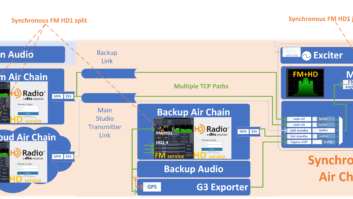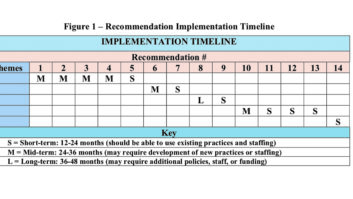As I inspected a site where a bush hog operator had bent a guy wire anchor, I thought of how such an accident could be prevented by simple marking of the wires at the anchor base plate.
Tom Moyer at Antenna ID Products has just the product: Guy Wire ID Marker Guard. It’s an 8-foot bright yellow plastic sleeve equipped with night reflective marking. The sleeve slips around the guy wire up to 1 inch in diameter and secures easily. A set of three markers is less than $100.
The company also sells Guy Wire Marker Balls, which are a pair of 12-inch-diameter ball halves that bolt together to form a brightly colored ball on the guy wire. Hardware is supplied, and the balls will fit up to 3/4-inch guy wires. Also sold in sets of three, this package is less than $300.
Antenna ID Products prepares a variety of tower marking products, including RFR signs and Exposure Guidelines signs. Visit the Antenna Site Store at www.antennaID.com.
. . .
(click thumbnail)Fig. 1: A Brother P-Touch labeler or similar device makes labeling quick and professional.Not only is a clean and simply designed site important, but just as labeling and identifying antennas and coax lines are important, so is labeling equipment within your site.
Take Mark Bohnett’s installation at WESM(FM) in Princess Anne, Md. He was sure to identify things like the coaxial transfer switch, even so far as to labeling the “manual drive” control so that an arrow directs the knob operation to select the appropriate transmitter.
As seen in Figure 1, a Brother P-Touch makes the labeling quick and professional.
Why is such labeling so important? If an RF transfer occurs, there’s no question which transmitter is being switched into the antenna if the switch is marked properly.
A few years ago, I was called into a station that was off the air. It had no operator’s handbook, and worse yet, nothing was labeled in the transmitter room.
In his effort to switch to the backup transmitter, the operator worked the transfer switch twice. The backup transmitter was running fine – into the dummy load. The switch pointer showed “Position 2” but the operator hadn’t a clue what Position 2 meant.
A clear label on the switch control knob, as well as on the transfer indicator pointer, as Mark has done, will eliminate confusion.
By the way, look at the heavy-duty bracing Mark used to support the switch. These switches aren’t light, and need proper support to prevent line flexing when the switch is turned.
(click thumbnail)Fig. 2: Pre-moistened towels keep hands and tools clean – and the bucket doubles as a handy work stool.


. . .
While you’re in the transmitter building, invest in a bucket of cleaning towels, like the Klein Tools “Klein Kleaners” shown in Figure 2.
These pre-moistened towels are great for keeping hands and tools clean.
Plus, the bucket makes a good makeshift stool to keep from sitting on a cold concrete floor as you do work behind an equipment rack.
Contract Engineer Bruce Blanchard keeps these Kleaners at all of his contract sites, and shares this tip with Workbench readers.
. . .
(click thumbnail)Fig. 3: The engineer tried to keep this transmission line off the ground …With winter weather just around the corner, so comes the yearly static problem.
We’ve used static mats with mixed results. I’ve heard of engineers resorting to carpet tiles, with the anti-static black backing, but Ron Castro at KRPQ/KMHX has given up on mats, carpet or linoleum under rolling chairs in the control room. His reason: the life expectancy of a typical mat under 24/7 use was a mere 30 days.
What’s the solution? Ron had a flooring company install industrial-grade parquet wood flooring tiles where the chairs rolled around, and he hasn’t had a problem since.
By the way, this was 10 years ago!
Another solution to consider is granite. Mike McCarthy of McCarthy Radio Engineering points out that its properties don’t allow conduction, and installation is about the same as a wood floor. Granite tiles will outlast wood and not require periodic recoating.
Use caution in selecting such stone tiles if your floor flexes. In Ron’s second floor studio location, the floor flexes, and granite, slate or marble tiles would crack.
Some might ask about sound reflections. But because such a small area is treated with the wood tiles – perhaps only 4 feet square, depending on your control room layout – the sound reflection effect is negligible.

. . .
What do you do when your high-power AM transmission line fails and you need to get back on the air? You run a temporary line, right?
One engineer did. Figure 3 shows an effort to keep the line off the ground as it snakes to the tower. The engineer went on to secure the splice kit with duct tape, as seen in Figure 4.
Undoubtedly he was working with little or no budget, under pressure to get the problem fixed.
(click thumbnail)Fig. 4: … and secured the splice kit with duct tape. Unfortunately these temporary fixes were made 10 years ago.
So what’s the problem? This was over a decade ago. Now the splice leaks and the line won’t hold power.
This temporary fix became permanent, and though it lasted for 10 years, the issue could have been averted if the problem was corrected properly the first time.
I still wonder how the bush hog operator avoided the line, but then judging from the small trees growing in the tower field, realize there was no bush hog operator. There was nothing but neglect.
These pictures reinforce the importance of conducting a thorough engineering “due diligence” prior to a purchase. The also pictures are a reminder of the problems we can sow, sometimes unwittingly, by compromising our standards to please upper management’s urgency.
Submissions for this column are encouraged and qualify for SBE recertification credit. Fax your submission to (703) 323-8044, or send e-mail to[email protected]













